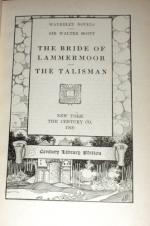The scene was worthy of an artist’s pencil. Under the very arch of the house of death, the clergyman, affrighted at the scene, and trembling for his own safety, hastily and unwillingly rehearsed the solemn service of the church, and spoke “dust to dust and ashes to ashes,” over ruined pride and decayed prosperity. Around stood the relations of the deceased, their countenances more in anger than in sorrow, and the drawn swords which they brandished forming a violent contrast with their deep mourning habits. In the countenance of the young man alone, resentment seemed for the moment overpowered by the deep agony with which he beheld his nearest, and almost his only, friend consigned to the tomb of his ancestry. A relative observed him turn deadly pale, when, all rites being now duly observed, it became the duty of the chief mourner to lower down into the charnel vault, where mouldering coffins showed their tattered velvet and decayed plating, the head of the corpse which was to be their partner in corruption. He stept to the youth and offered his assistance, which, by a mute motion, Edgar Ravenswood rejected. Firmly, and without a tear, he performed that last duty. The stone was laid on the sepulchre, the door of the aisle was locked, and the youth took possession of its massive key.
As the crowd left the chapel, he paused on the steps which led to its Gothic chancel. “Gentlemen and friends,” he said, “you have this day done no common duty to the body of your deceased kinsman. The rites of due observance, which, in other countries, are allowed as the due of the meanest Christian, would this day have been denied to the body of your relative—not certainly sprung of the meanest house in Scotland—had it not been assured to him by your courage. Others bury their dead in sorrow and tears, in silence and in reverence; our funeral rites are marred by the intrusion of bailiffs and ruffians, and our grief—the grief due to our departed friend—is chased from our cheeks by the glow of just indignation. But it is well that I know from what quiver this arrow has come forth. It was only he that dug the drave who could have the mean cruelty to disturb the obsequies; and Heaven do as much to me and more, if I requite not to this man and his house the ruin and disgrace he has brought on me and mine!”
A numerous part of the assembly applauded this speech, as the spirited expression of just resentment; but the more cool and judicious regretted that it had been uttered. The fortunes of the heir of Ravenswood were too low to brave the farther hostility which they imagined these open expressions of resentment must necessarily provoke. Their apprehensions, however, proved groundless, at least in the immediate consequences of this affair.




